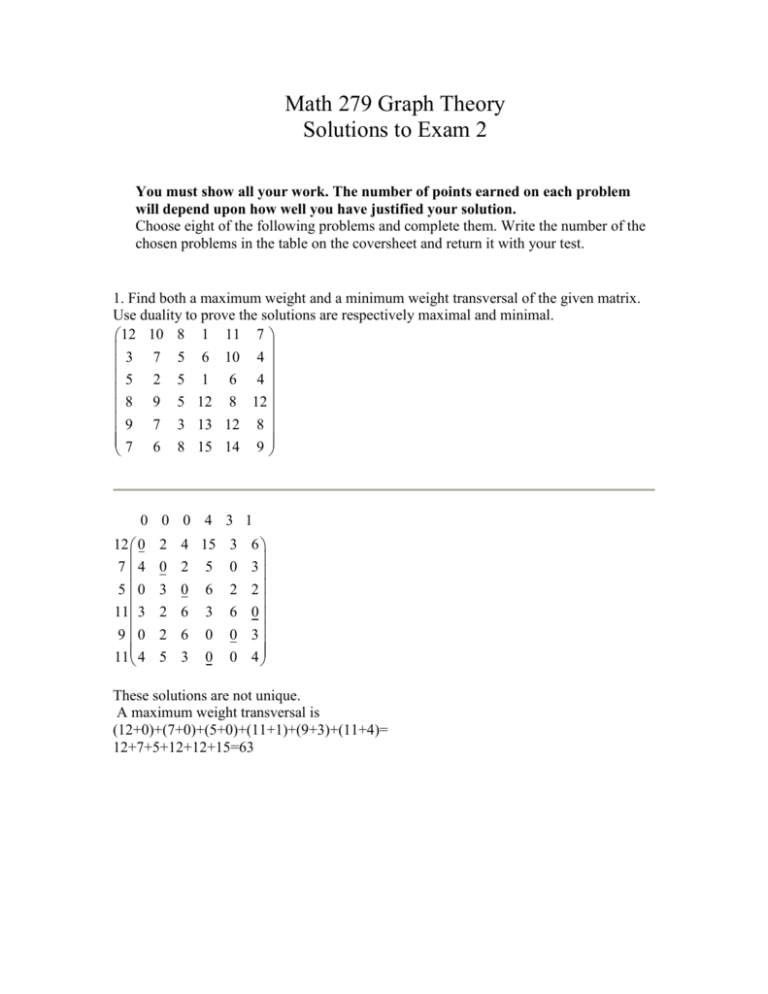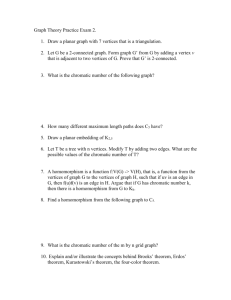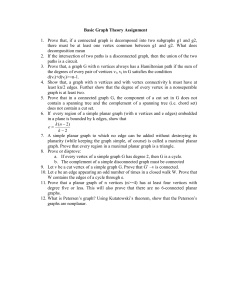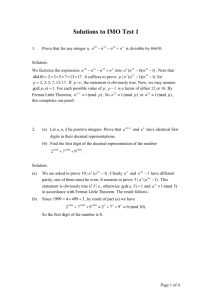theorem graph
advertisement

Math 279 Graph Theory
Solutions to Exam 2
You must show all your work. The number of points earned on each problem
will depend upon how well you have justified your solution.
Choose eight of the following problems and complete them. Write the number of the
chosen problems in the table on the coversheet and return it with your test.
1. Find both a maximum weight and a minimum weight transversal of the given matrix.
Use duality to prove the solutions are respectively maximal and minimal.
12 10 8 1 11 7
3 7 5 6 10 4
5 2 5 1 6 4
8 9 5 12 8 12
9 7 3 13 12 8
7 6 8 15 14 9
0 0 0 4 3 1
12 0
7 4
5 0
11 3
9 0
11 4
2
0
3
2
2
5
4 15 3 6
2 5 0 3
0 6 2 2
6 3 6 0
6 0 0 3
3 0 0 4
These solutions are not unique.
A maximum weight transversal is
(12+0)+(7+0)+(5+0)+(11+1)+(9+3)+(11+4)=
12+7+5+12+12+15=63
3 4 5 5 2 2
9 9 8 7 0 7 3
9 0 4 3 4 6 0
9 12 0 4 0 2 0
5 1 3 0 7 0 4
7 4 3 0 10 6 2
5 0 0 3 10 6 1
A maximum weight transversal on 15(identity matrix) minus the original matrix is
{14+12+11+7+12+9} = (9+5)+(9+3)+(9+2)+(5+2)+(7+5)+(5+4)= 65.
The minimum value is therefore 6(15)-67=1+3+4+8+3+6=25.
2. If a path Pn has a perfect matching then its adjacency matrix is invertible.
If an nn adjacency matrix M has a perfect matching then n is even.
Label the vertices of the path 1,2,3,…,n = 2k in order. To obtain the adjacency matrix,
name the rows with the odd labels (in order) followed by the even labels (in order). The
0 A
matrix will have the form T
where 0 is the kk zero matrix and A is a kk
A 0
matrix.
As constructed A is a lower triangular matrix with 1’s along its main diagonal and 1’s
along the next lower diagonal and zero elsewhere. That is, A is a lower triangular matrix
with 1’s along its diagonal, yielding a determinant of 1. Therefore, the determinant of AT
=1 and the determinant of the adjacency matrix equals 1 and it follows that M is
invertible.
3. Exercise 3.1.29.
By Theorem 3.1.16, if G is a bipartite graph, then '(G ) (G ) .
Take a minimum vertex cover of G of size (G ) . Any vertex in (G ) has degree at most
and since each edge is also covered by the vertices in (G ) , we can say
e(G )
e(G )
(G ) (G ) e(G ) (G)
. And, since '(G ) (G ) we have '(G )
;
(G )
(G )
e(G )
that is a matching of size at least
.
(G )
Let H be a subgraph of Kn,n with more than (k-1)n edges; that is, e(G ) (k 1)n . Since,
e(G ) (k 1)n (k 1)n
k 1,
by the above, there is matching of size m such that m
(G )
(G )
n
we are assured a matching of size at least k.
4. Exercise 4.1.15.
By 4.1.11, (G ) '(G ) where G is the Petersen graph.
We will use Proposition 4.1.12 to show G is 3-connected. We know that the removal of
three edges will separate the Petersen graph.
So, let us assume '(G ) 2 since (G ) 3 and '(G ) .
We need only consider 1 < |S| ≤ 5, since S 10 S and we would then consider the
subgraphs induced by S .
S , S 3 S 2e(G[ S ]).
If 1 ≤ |S| ≤ 4, e(G[S]) ≤ |S| - 1 since the girth of G is 5 and G[S] is a forest.
S , S 3 S 2 S 1 S 2 3.
If S 5, e 5 and S , S 15 2(5) 5.
In other words, any cut-set has at least three edges. Therefore, (G ) 3
5. Use induction to prove (G ) (G ) n 1 , where n = |V(G)|.
Induction on the number of vertices.
Base case. If n = 1, (G ) 1, (G ) 1 and (G ) (G ) 2 1 1.
Hypothetical Assumption. Assume (G ) (G ) k 1 for all graphs G such that |V(G)|= k <
n. We wish to show that (G ) (G ) n 1 for all graphs G with n vertices.
Consider a graph G such that |V(G)| = n > 1.
Then (G v) (G v) n by the induction hypothesis.
Suppose (G ) (G ) n 1 . This can only occur if (G v) (G v) n since
(G ) (G v) 1 and (G ) (G v) 1 .
It follows that degG v (G v) and degG v (G v) . Otherwise the vertex v would be
colored with one of the unused colors.
n 1 (G) (G) (G v) 1 (G v) 1 deg G v 1 deg G v 1 n 1 ,
a contradiction. Therefore, (G ) (G ) n 1 .
6. a. Use simplicial elimination to find the chromatic polynomial of the graph K1 Pn. (See
Exercise 2.2.16.)
b. Use induction, Theorem 5.3.6, and a) to prove that the chromatic polynomial of the wheel Wn =
K1 Pn is
(Wn ; k ) k (k 2) n (1) n k (k 2), n 3.
a) Label the vertex of degree n with 1 and order the vertices along the path from right to left with
2, 3,…n+1. By simplicial elimination, this labeling yields d(1)=0, d(2)=1,d(3)=2,…d(n+1)=2.
This implies ( K1 pn ; k ) k (k 1)(k 2) n 1 .
b) Induction on the number of vertices in Wn.
Base case. n = 3.
W3 K 4 with ( K 4 ; k ) k(4)
(W3 ; k ) k (k 2)3 (1)3 k (k 2)
(k 2) k (k 2) 2 k (k 2) k 3 4k 2 4k k
k (k 1)(k 2)(k 2) k(4)
Inductive hypothesis. Using Theorem 5.3.6:
(Wn ; k ) ( K1 Pn ) (Wn 1; k )
k (k 1)(k 2) n 1 k (k 2) n 1 (1) n 2 k (k 2)
k (k 2) n (1) n k (k 2)
7. Let G be a connected graph with (G; k )
n 1
(1) a k
i
I 0
i
n i
e(G )
t ,
2
. Prove that a2
where t is the number of triangles in G.
We use Theorem 5.3.10.
We obtain the exponent n-2 in two cases; |S| = 2 or |S| = 3. In the second case, this occurs when
G[S] is a triangle.
e(G )
ways to
2
When |S| = 2, we have n-2 components and the term (-1)2kn-2. Since there are
e(G ) n 2
k .
2
choose two edges in G, we have
If |S| = 3, we have n-2 components whenever the subgraph induced by S is a triangle. There is
then (1)3 tk n 2 in the chromatic polynomial. For |S| ≥ 4, c(G) ≤ n-3. The coefficient of kn-2 is
e(G )
t .
2
8. Use Theorem 5.3.10 to find the chromatic polynomial of the following graph.
|S|
0
1
2
3
4
5
6
7
c(G)
6
5
5
3
3,2
2,1
1
1
coeff
1
7
21
35
2,33
6,15
7
1
term
k6
-7k5
21k4
-35k3
2k3+33k2
-6k2-15k
7k
-k
(G; k ) k 6 7k 5 21k 4 33k 3 27k 2 9k
k (k 1)(k 2 3k 3)2
9. Let G be a planar graph in which every face is bounded by a triangle. If di is the number of
vertices of degree i, prove that
(6 i)d
i 1
i
=12.
Since di equals the number of vertices of degree i, we have
d
i 1
3f = 2e and n – e + f = 2. We also have the equality
id
i 1
i
i
n . G is planar which implies
2e .
6n 6e 6 f 12 6n 6e 4e 12 6n 2e 12
(6 i)d 6d id
i 1
i
i 1
i
i 1
i
6 di 2e 12
i 1
10. Prove that any 3-connected nonplanar graph G with |V(G)| ≥ 6 that contains a subdivision of
K5 also contains a subdivision of K3,3.
Let H be the subdivision of K5 in G. Let S = {v1, v2, v3, v4, v5} be the vertices in H of degree 4.
Note. K2,3 is a subdivision of H. We need only find one other vertex u such that it connects to any
three of the vertices in S along three nonintersecting paths.
Case I. There is a vertex of degree 2 in H. Say u is on a path P1 with endpoints v1 and v2.
Claim. There is a vertex u on the path P1 that connects v1 and v2 that is the endpoint of a second
path P2 that does not intersect P1 and has as its second endpoint vi S – {v1, v2}. Call it v3. If not
the deletion of v1 and v2 would disconnect the graph and we would have connectivity 2. We then
have a sixth vertex that is the endpoint of three nonintersecting paths to three vertices v1, v2, and
v3 in S.
Case II. There is no vertex u of degree 2 in H. As there are six vertices in G we have at least one
vertex not in H.
Since G is connected there is a path from u to any vertex in S. Say v1 is reached along a path P1
from u that does not include any of the other vertices of S. Since the degree of u is 3, u is adjacent
to a vertex not on P1 (possibly in S – v1) that is on a path ending at a vertex in S – v1. Otherwise,
we could delete v1 and separate the graph making G 1-connected. Say we now have a path P2
between u and v2 that does not intersect P1.
Claim. Consider the cycle consisting of P1 and P2 and the edge v1,v2. There is a path P3 beginning
at one of the vertices, call it v v1 or v2 and terminating at one of the vertices in S – {v1, v2}.
The path P3 does not intersect P1 or P2. If all such possible paths intersected P1 and P2 then v1 and
v2 would be cut-vertices and G would be 2-connected, a contradiction.
We therefore have our required three nonintersecting paths.










